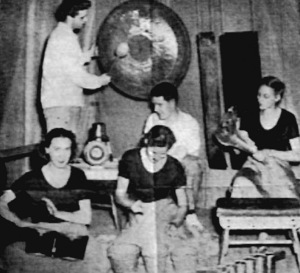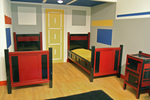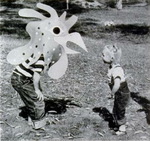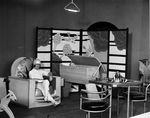I just got Begin Again, Kenneth Silverman's new biography of John Cage, for Christmas, so I'm not very far in. But it's already full of surprises. Like, for example, an offhand mention that while he was teaching at The Cornish School in Seattle in 1938, Cage composed music for kids: "percussion music for dances by children in 'Mexican Fiesta,'" to be precise. "Mexican Fiesta"!? Que es eso? Silverman no se.

But here we go, from the 1998 biography of Bonnie Bird, the pioneering modern dancer and educator who hired Cage to be her accompanist, and who taught a young Merce Cunningham. Joan is around seven, and her dad Ralph Gundlach is Bird's new husband:
Cage also worked with Bonnie at the Bush School where Joan, Ralph's daughter, was a student. There, the eight-to-ten-year olds were required to take dance classes and Bonnie had to struggle to find ways to hold their interest. She and John decided to focus on a production, something neither had ever attempted before with youngsters. They quickly discovered taht once children knew their goal was a performance the impossible could be accomplished. For the spring festival Bonnie stages a Mexican fiesta, with musical accompaniment by the students on instruments they had made under John's direction.That's about it, but Cage was also working with students on some of the first concerts devoted solely to percussion, soliciting scores from a veritable who's who [sic] of Pacific Northwest modernist percussionists and composers:Teaching dance to children was a new development for Bonnie, and she quickly understood taht she knew little about child psychology. She read everything she could get her hands on and often asked Ralph for advice. While he was no teacher of young people, he did have enormous understanding and seemingly endless resources.
Some of the instruments they asked for were quite unusual, like the jawbone of an ass which had to be hit hard to make the teech clatter, and a bull-roarer, a struck gong whose vibrations slowly died wile it was being dipped into a bucket of water. In many cases John and the students had to make the instruments.Whoops, that's where Google Books cuts it off.Ray Green based his 3 Inventories of Casey Jones for pop bottles, bottle with marbles, drums, cymbals, gong and piano on a popular folk song.
I can't find a photo of the Mexican Fiesta, but the picture above is of Cage's early Cornish School percussion concert. One of which, miraculously, was recorded on 78rpm record by Lou Harrison in 1939, and was rediscovered and broadcast by Charles Amirkhanian in 1971. You can stream or download it from Archive.org.
You know, we just put the kid in classical ballet this year, and it's great/fine. But I have wondered for a long time if, after nearly a hundred years of modern dance, another educational paradigm hadn't grown up somewhere. Did everyone who dances professionally still train as a classical dancer and then have to decide as an adult whether/when/how to "rebel" against it? That made no sense. But now I have to start looking into this Bonnie Bird thing. I had no idea. Team Ballet, I think I might need to see you out in the hall.
Ode to Gravity: Percussion Music: From Lou Harrison's collection of 78 rpm acetate records (March 10, 1971) [archive.org via sequenza21]





